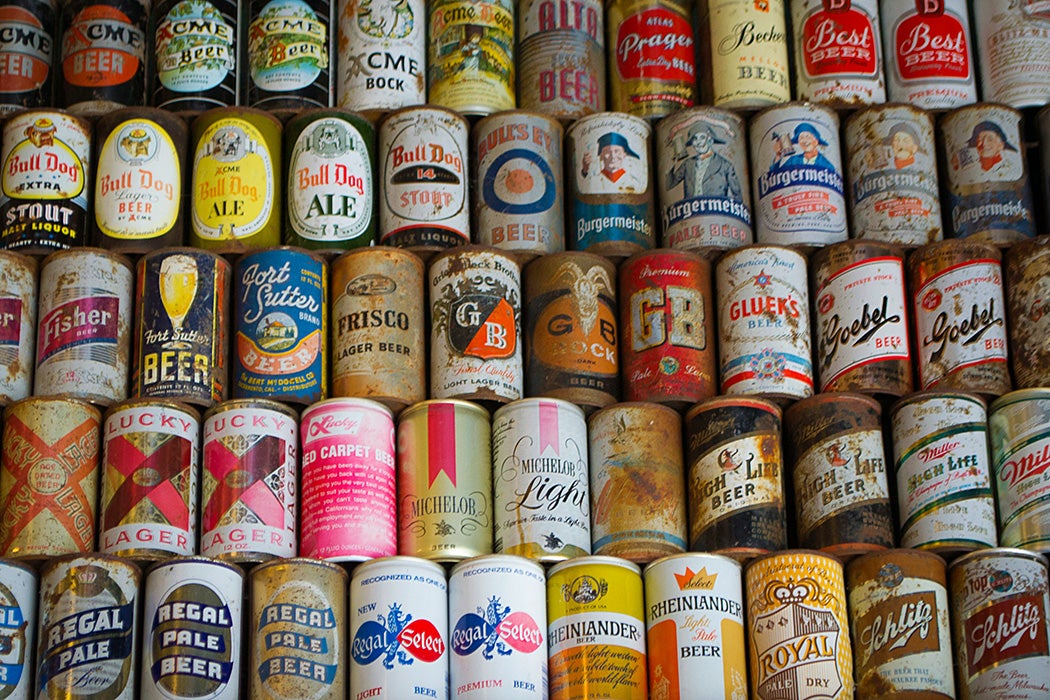In 1993, David Maxwell noticed a troubling shortage of foolproof guides for dating beer cans. In an effort to fill that void, the archeologist, who has collected over 4,500 antique beer cans throughout his life, compiled a handy field-identification guide meant to assist researchers in pinpointing “changes in major and minor design features [in beer cans]…to yield age estimates accurate to within five years of production.”
The archeological study of beer cans is a small niche within the field of “tin can archeology.” For archeologists, the value of tin cans comes from one key feature: disposability. According to archeologist Jane Busch, “Immediate disposal makes the…can a valuable dating tool for archaeologists,” since “there are few uses for an open tomato can once the tomatoes are gone.” Even though beer cans are relatively modern compared to something like a Civil War–era metal milk can, Busch argues, “The historical archaeologist who ignores the beer can at his site is like the prehistoric archaeologist who ignores historic pottery.”
The first beer cans didn’t appear on the market until 1935. According to Maxwell’s guide, the surest way to roughly date these early tin-lined steel cans is to look at the label. (If you see “Internal Revenue Tax Paid,” for example, you know it’s from between 1935 and 1950.) But if the can is too worn to identify, Maxwell explains, the next best point of reference is the shape.
The most popular shape was the cone-top (a can topped with a funnel-shaped head and sealed with a bottle cap). This narrow-nosed container was familiar to beer drinkers and relatively easy for factories to produce, since it resembled traditional beer bottles. Conversely, patrons were initially dumbfounded by the classic cylindrical beer can with a flat top and bottom. Early cans were even sold with “opening instructions, usually with illustrations…included as part of the label,” writes Maxwell.
In the 1940s, he explains, “canned beer production for the U.S. domestic market ceased…because of restrictions in the availability of tin plate.” Still, over a million cans were shipped overseas for the military. Soldiers got to drink their brews out of specially made olive and silver camouflage-friendly cans. After the war, as domestic production came back, cans exploded in popularity and their look became more homogeneous. The once-arcane flat-tops won out over cone-tops, because they were easier to make, fill, and store.
Weekly Newsletter
The next major development came with the invention of pull-top tabs in the 1960s. These early tabs fully detached from the cans and caused such an excessive litter problem that Oregon banned them completely. This led to the invention of the “StaTab.” In the 1970s, lightweight aluminum cans took over the industry. Companies also got a lot more creative: If you find a funky specialty beer can (like one in the shape of a barrel or decorated to commemorate the Bicentennial) it’s probably from this period. The ’70s and ’80s brought ring-pull cans, push-button cans, cans with more tapered edges, and, eventually, computer codes and government warning labels.
For archeologists like Maxwell, the fact that beer cans are present “on virtually all parts of the landscape…suggests that [they] should be employed by archaeologists interested in inferring the age of historic deposits, or the date of intrusion on prehistoric sites.” Clearly, the humble beer can has a life long after it is emptied.
Support JSTOR Daily! Join our new membership program on Patreon today.







